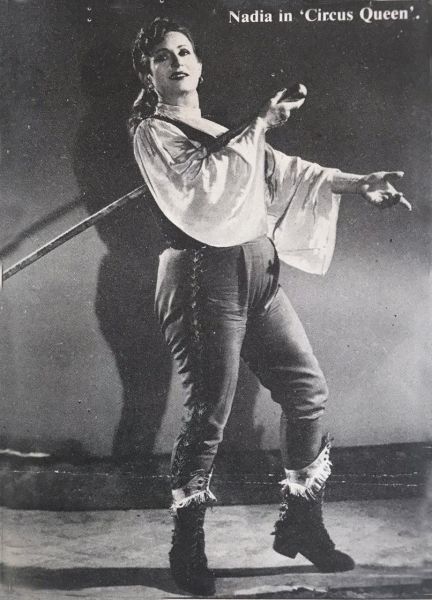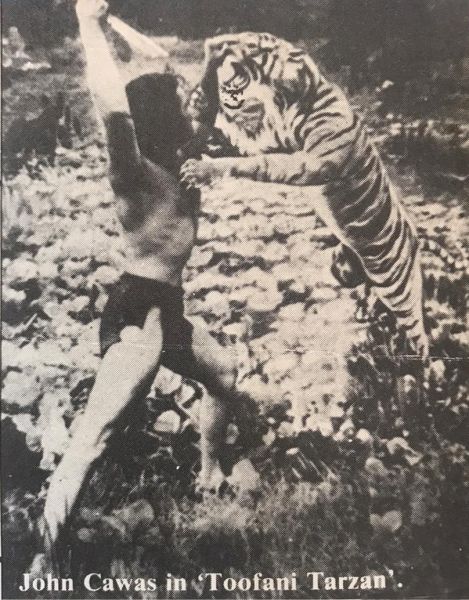The names of the Wadia Brothers and Fearless Nadia were known from corner to corner of the country for their ‘stunt’ movies, but as J.B.H. Wadia points out in this article, they were not just action films. Also, Wadia Movietone made a variety of films - socials, musicals, document etc. – which include a series of ‘firsts’.
I was interested in the new medium of cinema from my boyhood - first as a filmgoer and in course of time also as a student and cineaste. But my eventual entry into the film lines was due to a series of fortuitous circumstances. As I have dealt at length on the first phase of my film career in the closing years of the Silent Era in the first volume of my memories ‘Those Were The Days’ I pass over the details here.
All my low-budget stunt films made between 1929 and 1933 had clicked – in their limited sphere, of course. But the fact that I could do so in the face of the newly - arisen threat of the talkie had bolstered my morale appreciably.
In my first talkie ‘Lal-e-Yaman’ there were classical and semi-classical songs sung by my golden-voiced young star Firoze Dastoor, who in later years, become an acknowledged pundit of the Kirana Gharana. The experiment succeeded and ‘Lal-e-Yaman’ became the talk of the town. It helped me to found Wadia Movietone Studios in the vernal surrounding of Lovji Castle at Parel. It was an ancestral estate of the India Co., and then the Government of India. I adopted the insignia of the ship as the emblem of my company. I used to advertise my films as “A cargo load of rich variety brought into port by the Wadia Ship.”
Peerless Nadia
Then I wrote and produced ‘Hunterwali’ with Fearless Nadia as a stop-gap film. It was directed by Homi under my personal supervision. It’s phenomenal success at the box-office changed the image of Wadia Movietone radically. The returns were like manna from Heaven. Nothing succeeds like success, more so in show business. Naturally, there was pressure on me from all side to make films like ‘Hunterwali’. And I also did not resist. After all, money makes the mare go. I jumped the obliging steed readily and galloped on for some years to come. And found I had left behind whatever dreams I had secretly nurtured of reaching “the cloud-capp’d” towers, the gorgeous palaces – in the realm of socials and musicals.

Nadia was the Ursa Major in the firmament of Wadia Movietone. All her films were directed by Homi.
‘Jai Bharat‘ with Sardar Mansoor and our wonderhorse Punjab-ka–Beta, ‘Toofani Tarzan’ and ‘The Jungle King’ with John Cawas, ‘Jai Swadesh‘ with Benjamin, ran neck to neck with Nadia vehicles at the box-office.
.jpeg/WhatsApp%20Image%202020-06-15%20at%207_39_56%20AM%20(1)__421x600.jpeg)
My colleagues in the industry could not understand why J.B.H. Wadia‘s’ stunt’ films fared better than some of their prestigious socials. I have never been a shrewd businessman. But for once I played my cards well. I did not reveal the secret of my formula, not till I reverted to socials in 1941 with ‘Raj Nartaki’ and its English version ‘The Court Dancer’ with that incomparable danseuse and cultured lady, Sadhana Bose. Incidentally, ‘The Court Dancer’ was the first film in English to be entirely produced in India with complete Indian personnel and Indian finance.
The Theme’s the Thing
Stunts, comedy and fast action had a lot to do with the success of my so-called ‘stunt’ films. I say “so-called” because there was always something more, something different in them. I had tried to raise the standard of those films in my own way by weaving my screenplays around the burning problems of the day. I was in the Indian National Congress from 1930 to 1938. The themes of Hindu Muslim unity and the struggle for freedom became a passion with me. They figured again and again in my screenplay and I often wrote out the first drafts of the pivotal dialogue.
Other vital themes of my films were untouchability, literacy campaign, dignity of labour, plea for democracy, anti-fascism and last, but not least, the emancipation of Indian womanhood. If Wadia Movietone’s early action films had left an indelible mark on filmgoers and are remembered even today with affection, it is also because of these various themes.
The urge to do something different had prompted me as far back as 1934 to stage ‘Hamlet’ on a professional scale for the first time in Western India, if not India itself, with the great thespian Jal Khambatta as director and as Shakespeare’s tragic hero. In the third show at the Empire Theatre, my Ophelia, Miravati Devi, sister of Sarojini Naidu, met with a serious accident, I could not ask my financing partner to undergo further loss in a non-filmic fad of mine and I pulled the curtain down on Wadia Theatricals for good.
“Stunts, comedy and fast action had a lot to do with the success of my so-called ‘stunts’ films. I say ‘so-called’ because there was always something more, something different in them.”

“Children of the Mind”
I was extremely interested in Indian classical music. Between 1933 and 1942, I produced a series of short films of musical value and released each issue, a thousand feet long, with every feature film. It was a non-profit making venture and labour of love for me. It was a rare treasure house of musical items rendered by some of the master musicians of the earlier generations such as Ahmed Jaan Thirakhwa (Tabla solo). Sakhawat Husein Khan (Sarod), Habib Khan (Bichitra Beena), Ghazals by Malika Pokhraj of Lahore and Zohra Ambalawali, a rendering of “Goverdhan Giridhari” in Mandzinjoti by Kumar Gandharva, aged nine. Thumris and Ghazals by Sangeet Ratna Firoze Dastoor, Sufi qawalis by Azim Prem Ragi or Ajmere Sharif amongst others, and last but not least, two superb Ghazals of Hazrat Jigar Muradabadi rendered on the screen by the doyen of Urdu poetry himself, and one more by Shakeel Badayuni . Prints of this unique series (which I have called “children of the mind”) with other excerpts of technical and historical value from my feature films are with the National Film Archive of India, Pune.
Wadia Movietone was the first film studio in Bombay to declare two Sundays as holidays and bonus to the staff every year between 1933 and 1942 - and that too at a time when trade unionism did not exist, at least in the film industry.
Wadia Movietone also had a cricket club of its own. Our coach was no less a cricketer than Homi Vajifdar – that great all-rounder of the previous generation.
“Extra – curricular’
Here, I must deviate a little to record an important aspect of my ‘extra-curricular’ activities. It was in 1937 that I came into direct contract with M.N. Roy. Although he was a non-conformist Communist at the time he came out of jail, in 1936, he joined the Indian National Congress. Roy could do so because he was a revolutionary who was also a thinker. I was attracted to him because of his towering intellect and his sterling honesty as a thinker. I soon became a Royist and ever since the unique dissolution of the Radical Democratic Party of India, I have been a radical humanist. The subject is outside the scope of this article. Suffice it to say that my wife and Associate Producer (known in the film trade as Hilla Wadia in her own right) and I consider ourselves singularly fortunate in having known Roy and his equally brilliant wife Ellen. Their deaths have left an unbridgeable gap in our life.
Those were the halcyon days of film-making, an undiluted pleasure for all of us. We worked as a team. The entire staff - from the stars to the last coolie - was on the payroll. This enabled us all to meet each other regularly. Camaraderie prevailed. All were equal and so far as production proper was concerned, he who called himself the boss was not “more equal.” In the assembly of Wadia Movietone, “Na koi banda tha - Na koi banda nawaz.”
Indeed, “Those were The Days, My Friend/We Thought Would Never End.”
……..But they did. In the wake of the so-called freelance system, the old order changed yielding place to new. And thereby hangs another tale…..
This is a reproduction of the oriinal published in Fifty Years of Indian Talkies (1931-81) published by Indian Academy of Motion Picture Arts and Sciences, 1981.
Tags
About the Author







.jpg)


